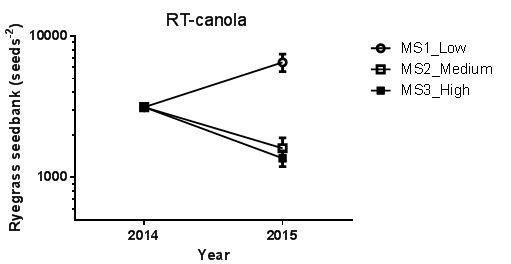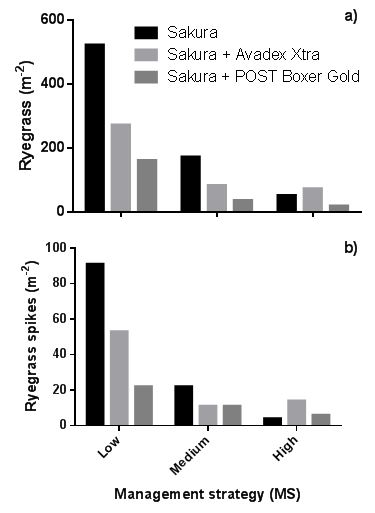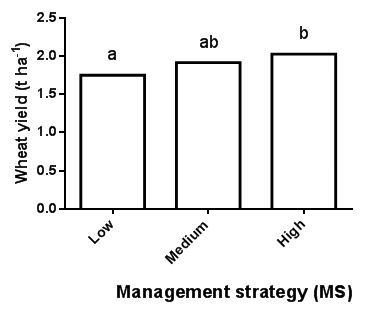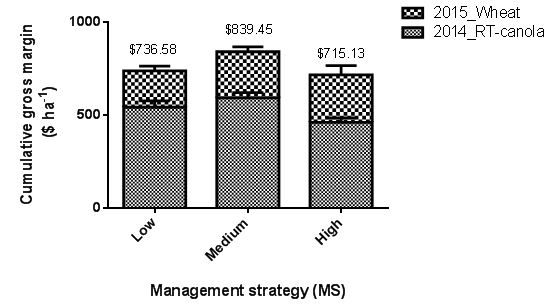Managing Select resistant ryegrass in canola and wheat
Author: Sam Kleemann (School of Agriculture, Food & Wine), Felicity Turner (MacKillop Group), Gurjeet Gill and Chris Preston (School of Agriculture, Food & Wine) | Date: 24 Aug 2016
ɸExtra technical comment by Protech Consulting Pty Ltd
Background
There is increasing prevalence of annual ryegrass with resistance to Select® (active ingredient (ai) clethodim) across southern Australia. The loss of this important grass selective herbicide is making management of ryegrass far more difficult in break crops, where traditionally growers expect greatest control. In an effort to achieve acceptable control, higher rates of Select EC 240 (500 mL/haɸ) have become widespread industry practice. However the sustainability of this approach is being questioned with reports of crop damage in canola. Furthermore, resistance to important post-emergent herbicides means growers are now placing greater reliance on pre-emergent herbicides, particularly in the cereal phases of the rotation.ɸn.b. highest rate on the Select EC 240 label is 500 mL/ha.
As a consequence a two year trial has been undertaken on the Victorian side of Frances to investigate the impact of different management strategies in RT-canola and wheat on the long-term control of Select®-resistant ryegrass.
What’s been undertaken?
In yr-1 of the two year study, RT-canola (RT-Hyola 525®) was established and three management strategies employed of low, medium and high intensity (Table 1). RT-canola was followed by Mace wheat in 2015, however plots of each management strategy were further divided into three herbicide subplots of Sakura®, Sakura® + Avadex Xtra® and Sakura® followed by POST Boxer Gold®.Table 1: Management strategies used in long-term ryegrass trial at Frances in 2014 (RT-canola phase) and 2015 (wheat).
| Management Strategy (MS) | RT-canola phase | Wheat phase |
|---|---|---|
| Low intensity (MS1) | Simazine (1.1 kg/ha) pre Atrazine (1.1kg/ha) + Select EC 240 (500 mL/ha) post | Sakura (0.118 kg/ha) pre |
| Medium intensity (MS2) | Simazine (1.1 kg/ha) pre RoundupReady (0.9 kg/ha) cotyledon RoundupReady (0.9 kg/ha) + Atrazineɸ (1.1 kg/ha) 6-leaf | Sakura (0.118 kg/ha) + Avadex Xtra (2 L/ha) pre |
| High intensity (MS3) | Rustler (1 kg/ha) + Avadex Xtra (2 L/ha) pre RoundupReady (0.9 kg/ha) cotyledon RoundupReady (0.9 kg/ha) + Atrazineɸ (1.1 kg/ha) 6-leafWeedmaster DST (2.4 L/ha) crop-top | Boxer Gold (2.5 L/ha) post |
The replicated trial was sown to Mace wheat at 90kg/ha on 26 May using a standard knife-point press wheel system on 22.5cm (9 inch) row spacing. Fertiliser rates were applied as per district practice. Pre-sowing herbicides were incorporated within a few hours of application, while post-emergent Boxer Gold® was applied to ryegrass at the 1-2 leaf growth stage. Herbicide screening confirmed resistance in the ryegrass population to both Select® and Factor® (Butroxydim). Assessments included ryegrass control (reduction in plant, seed set and seedbank), crop yield and grain quality.
Results and discussion
Following RT-canola in yr-1 of the study clear differences in ryegrass seedbank emerged between management strategies (Figure 1). Where reliance was placed on simazine and Select® under the low intensity management strategy (i.e. standard grower practice), this failed to provide adequate control and seed set prevention; the ryegrass seedbank increased by more than two-fold (6509seeds/m2) the initial seedbank (~3137seeds/m2). Ryegrass is a prolific seed producer and in the absence of effective control with Select® it would have flourished (~303spikes/m2) resulting in significant seed production. This is consistent with grower observations that ryegrass often appears worse following a canola phase, where Select® has failed either because of an application error or due to herbicide resistance.
In contrast, the seedbank declined by 49 and 54 per cent under the medium (MS2) and high intensity management strategies (MS3) respectively where ryegrass was far more effectively controlled. In-crop glyphosate (cotyledon and 6-leaf canola GS), including late crop-top when canola was at 20 per cent seed colour change, proved to be extremely effective at preventing ryegrass seed set.

Even though ryegrass was unable to set much seed under MS2 and MS3 there was still moderate infestation prior to sowing wheat in 2015; presumably from the persistent fraction of the seedbank. However, persistence at this site appeared higher than the 10-15 per cemt carryover often reported for ryegrass (Chauhan et al.) and was probably related to the dry conditions experienced in 2014.

Not surprisingly there were clear and significant (P<0.05) differences in ryegrass density in response to the different management strategies imposed in the canola phase. The legacy effect of the canola phase was greatest in the low intensity treatment (MS1), where control with Select® was poor, resulting in significantly more ryegrass relative to both MS2 (2-fold) and MS3 (4-fold). Because of the large ryegrass population in MS1, pre-emergent herbicide treatments were placed under considerable pressure in the wheat phase. Sakura® alone struggled with this initial weed pressure (522plants/m2), whereas its tank mix with Avadex® was far more effective on ryegrass providing an additional 48 per cent improvement in control (Figure 2). Even better again was Sakura® followed by post Boxer Gold® (69% improvement). Boxer Gold® applied early post-emergence has proven to be a reliable option provided it’s applied to small ryegrass (<2-leaf) and sufficient rain is received within a week after application (i.e. 5-10mm).
Fortunately ryegrass seed set was severely affected by the lack of spring rainfall, with ryegrass struggling to set viable seed. On average only one in every five ryegrass plants was capable of producing a viable spike, with Sakura® treatment under MS1 resulting in the highest spike density (91spikes/m2). The root system of ryegrass is often pruned and stunted after treatment to Sakura®, and this probably contributed to reduced seed set by exacerbated moisture stress during the dry spring. Only under medium (MS2) and high intensity management strategies (MS3), where reasonable ryegrass control was obtained in the canola phase was ryegrass adequately controlled with pre-emergent herbicides in wheat. Not until seedbank sampling is undertaken again in April next year will the effectiveness of each herbicide by management strategy on depleting the seedbank become clear.

Figure 3: Wheat yield for low (MS1), medium (MS2) and high intensity management strategies (MS3) at Frances in 2015. Because herbicide effect on wheat yield was non-significant data were combined over herbicide treatment and presented as the mean of management strategy. Different letters indicate significant differences between means.
Although there were clear differences in ryegrass control between pre-emergent herbicide treatments, this had little effect on the grain yield of wheat (P=0.05) and data were subsequently combined over herbicide treatments. However, large differences in ryegrass density between management strategies were reflected in wheat grain yield (Figure 3). As a consequence of reduced competition from ryegrass MS3 (high) produced between 6 to 16 per cent more grain than MS2 (medium) and MS1 (low), respectively. The benefits of improved weed control with Sakura® and post Boxer Gold® appeared to be largely offset by the dry conditions during flowering and grain fill.

Figure 4: Effect of management strategy (MS1-3) on cumulative gross margin for the two year rotation (RT-canola/wheat) at Frances. Gross margin estimates are based on crop yield, farm expenses and historical commodity prices averaged from 2011 to 2015 (Source: Rural Solutions 2014 & 2015 Farm Gross Margin & Enterprising Planning Guide). Vertical bars represent SE.
Despite the superior ryegrass management under MS3, cumulative gross margins over the two year cropping sequence were three per cent and 17 per cent better for MS1 (low) and MS2 (medium; Figure 4), respectively. This result was reflective of the significantly higher weed control expenses incurred in the canola phase with MS3 (high: $97/ha) relative to MS2 (medium: $34/ha) and MS1 (low: $27/ha).
Conclusion
The results have clearly shown that effective management strategies used in a canola and wheat cropping rotation can provide long-term management of Group A resistant ryegrass. Ability to reduce ryegrass seed set and seedbank replenishment in the initial phase of a two year break appears to be crucial. However, because ryegrass is a prolific seed producer, failure to provide effective control over consecutive seasons can lead to a large rebound in weed infestation. Whilst the economic benefits were not fully realised from this study (due in part to historically dry seasons), maintaining ryegrass seedbanks at low levels is critical given its competitiveness and propensity at high densities to rapidly evolve resistance to different mode-of-action herbicides.
References
Rural Solutions SA. (2014 & 2015) Farm Gross Margin and Enterprise Planning Guide Barton, ACT, Australia: Grains Research and Development Corporation
Acknowledgments
We are grateful to Louie and Charlie Koch for allowing us to undertake the trial on their property, and the SARDI team from Struan for planting and maintaining the trial.
Contact details
Sam Kleemann
University of Adelaide
samuel.kleemann@adelaide.edu.au
Was this page helpful?
YOUR FEEDBACK
